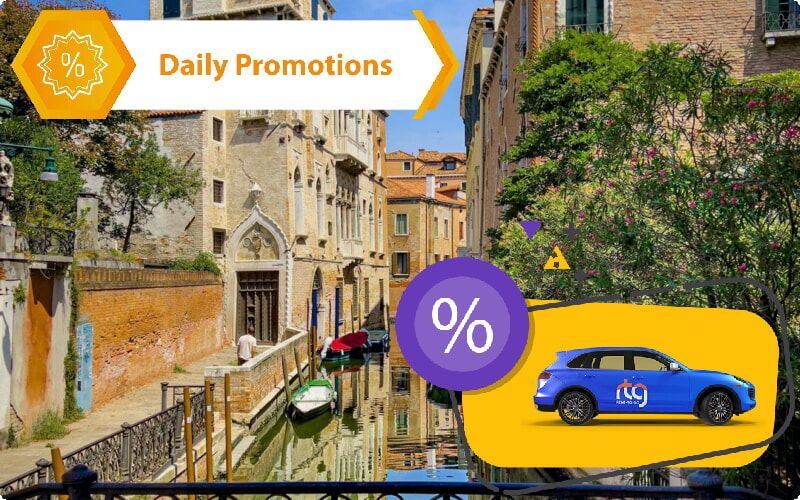 Up to
-35%
Up to
-35%
Venice, renowned for its canals and historic architecture, is a unique city where traditional car hire might not be the most straightforward option. However, if you plan to explore the surrounding areas, hiring a car can be quite beneficial. Here’s what you need to know about car hire in Venice:
Car hire services are not available within the main island of Venice due to its canal-based transportation system. Instead, you can find car rental agencies in nearby locations such as:
While driving in Venice itself is not possible, a hired car can be useful for exploring the Veneto region and beyond. Here are some tips:
If you prefer not to hire a car, Venice offers excellent public transportation options:
In summary, while car hire in Venice itself is impractical, renting a car from nearby locations can enhance your travel experience by allowing you to explore the beautiful Veneto region and beyond. Plan ahead, understand local traffic laws, and consider alternative transportation options for a smooth and enjoyable trip.

Exploring Venice and its surrounding areas with an electric car is an eco-friendly and convenient option. Several popular electric car models are available for rent, each offering a unique blend of comfort, efficiency, and style. Here are some of the top choices and their average daily rental rates in Euros:
These rates provide a general idea of what to expect when renting an electric car in Venice. Prices may vary based on the rental company, season, and availability, so it's always a good idea to book in advance and compare options.



One way car rental options in Venice offer flexibility for travelers looking to explore Italy without the need to return to their starting point. Many rental companies provide this service, allowing you to pick up a car in Venice and drop it off in another city. This is particularly convenient for those planning to travel across the country or continue their journey to other European destinations.
For example, renting a car in Venice and returning it in Rome typically incurs an additional fee ranging from €50 to €100, depending on the rental company and the type of vehicle. Dropping off the car in Milan might cost around €70 to €120. If you plan to return the car in a neighboring country, such as Austria or Slovenia, expect to pay a higher fee, usually between €150 and €300.
It's advisable to compare rates from different rental companies and book in advance to secure the best deals. Always check the terms and conditions for one-way rentals to avoid any unexpected charges.
One of the simplest yet most effective ways to save on car rentals is to book well in advance. This is particularly important in tourist-heavy locations, where demand for rental cars can spike during popular travel seasons. By booking ahead of time, you can take advantage of lower rates and ensure that your preferred vehicle type is available.
Many car rental companies in Venice offer "early-bird" specials to customers who book weeks or even months ahead of their planned rental dates. These deals can offer significant discounts, sometimes up to 20% or 30% off the regular price. Booking in advance is especially beneficial if you plan to travel during peak seasons when prices are likely to soar due to high demand.
Booking ahead not only helps you save money but also gives you the flexibility to shop around and compare prices from different suppliers. If your travel dates are flexible, you can also adjust them to periods when rates are lower, ensuring even more savings.
For the best deals, consider using our website, r-tg.com. We aggregate rates from various suppliers, providing you with a one-stop shop for comparison. The site often features exclusive early-bird specials and promotional discounts that you won't find anywhere else. It's an excellent resource for locking in the lowest possible rate for your rental car in Venice.
Scouring multiple sources for car rental rates is one of the best strategies to secure a cost-effective deal. Different rental companies have varying price structures, and the cost can differ widely even for identical vehicle categories.
Let's say you're interested in a compact vehicle like a VW Polo. While you may initially lean toward established brands like sixt or budget, don't overlook smaller, local agencies. These lesser-known providers may offer enticing rates to lure customers away from larger competitors.
For example, renting a VW Polo from sixt could set you back €16 per day, with basic insurance included. In contrast, budget might charge €76 per day for the same car, but with a limited mileage allowance. A more thorough search could reveal a local vendor offering the VW Polo at a daily rate of just €14, with unlimited mileage to boot.
Using discount codes can significantly reduce your car rental costs in Venice, offering you the chance to upgrade your vehicle class, extend your rental period, or simply save money. These promotional codes or coupons are not just for the savvy coupon-clipper; they are a mainstream and widely accepted practice in the car rental industry.
There is a wide array of discounts you might be eligible for. For instance, AAA members often enjoy reduced rates or additional perks like a free additional driver. Military personnel and their families can also benefit from special rates. Even holding a particular type of credit card could make you eligible for specific discounts or additional coverage. Always check what types of discounts you might qualify for, as they can stack up and result in substantial savings.
Discount codes can be found on a variety of platforms, including:
While discount codes can offer significant savings, they may come with specific terms and conditions, such as blackout dates or limited vehicle classes. Always read the fine print to ensure the discount applies to your specific rental needs.
The prepaid fuel option may seem like a convenient choice at first glance. After all, who wants to rush to find a gas station right before returning a rental car? However, this convenience often comes at a premium, and refueling the car yourself can lead to significant savings.
When you choose the prepaid fuel option, you're essentially paying for a full tank of gas at the rates set by the rental company. This rate often includes a markup, making it more expensive than what you'd pay at a local gas station. Additionally, if you don't use the entire tank, you usually won't receive a refund for the unused fuel, leading to even more wastage.
It's wise to plan your refueling strategy in advance. Look up local gas stations near your drop-off location and check their rates using apps or websites. Some mobile apps even offer real-time gas price comparisons, allowing you to find the cheapest rates nearby.
If you're not planning to drive much during your rental period, you might end up returning the car with a nearly full tank, making the prepaid fuel option an even less economical choice. Always consider your driving itinerary and needs when making this decision.
While skipping the prepaid fuel option can save money, it may require extra time and planning on your part. Weigh the cost savings against the value of your time to determine if it's worth the effort.
In summary, while the prepaid fuel option offers convenience, it often does so at a higher price. By doing some quick math and planning your fuel stops, you can save money and ensure you're getting the best deal on your car rental.
Choosing an economy car can save you significantly on both rental and fuel costs, which is crucial in areas with high gas prices or for extended journeys.
Economy cars are not only cheaper to rent but also fuel-efficient. They are also more manageable in crowded or tight spaces.
Consider an electric vehicle (EV) for additional fuel savings and a smaller carbon footprint. While the rental rate might be higher, fuel savings can offset it.
An EV like the BMW i3 could negate fuel costs if you find free charging options.
Some cities allow EVs in carpool lanes, saving you time on the road.
In summary, economy and electric cars are both cost-efficient and eco-friendly options. Compare rental and estimated fuel costs to find the best fit for your trip.
Many travel websites provide package deals that encompass flights, hotels, and car rentals. By combining these services, you can frequently secure substantial savings.
Booking the smallest and least expensive car available might seem counterintuitive, especially if you desire a larger or more luxurious vehicle. However, this can be a clever way to save money and potentially enjoy a free upgrade.
Car rental agencies typically have a limited inventory of small, economy cars since these are the most popular and frequently booked options. If you book the smallest car and the agency runs out of that class when you arrive, they are usually obligated to give you a free upgrade to the next available class. This means you could end up with a midsize car, or even a sedan, for the price of an economy car.
It's important to note that this strategy is not a guarantee. You might arrive and find that small cars are indeed available. In that case, you'll get what you paid for, which is still a cost-effective option. However, the potential upside makes this a gamble worth considering for the budget-conscious traveler.
Before choosing the rental company's insurance, review your own auto insurance policy to determine if it covers rentals. If it does, you can avoid the extra cost.
Car hire services in Venice frequently offer special deals, especially during holidays or off-peak times. To stay updated on these short-term offers, consider subscribing to their mailing lists or regularly checking their websites. They may also announce exclusive promotions on their social media channels.
Incorporating these tips into your travel plans can significantly increase your chances of securing an affordable car rental. In a city as dynamic as this, being a savvy consumer can make a substantial difference in optimizing your travel budget.
Don't overlook mileage limits in Venice car rentals; they can lead to unexpected fees.
Rental firms offer unlimited, daily, or total trip mileage plans. Choose wisely to avoid extra costs.
Exceeding the limit can cost between $0.25 and $0.75 per extra km.
Inquire about mileage policies when you pick up the car and negotiate better terms if possible.
Being savvy about mileage can keep your travel budget on track.